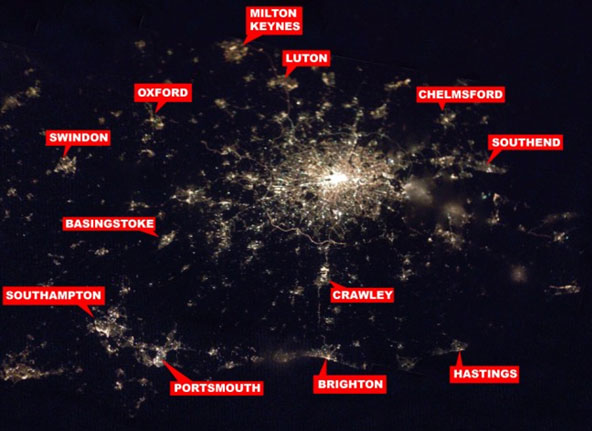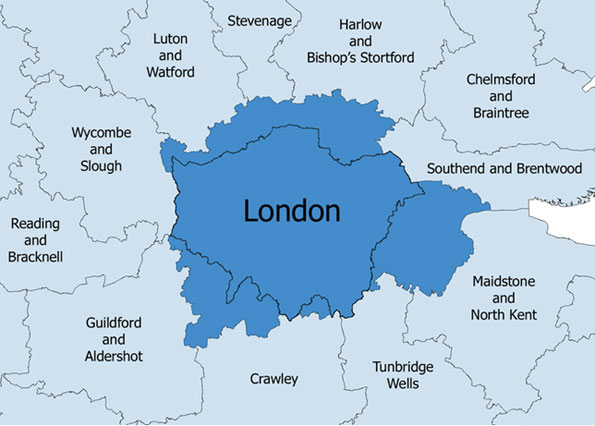
(Part I of II.) The writer Ford Madox Ford summarised the inventiveness of the early twentieth century in an essay The Future of London (1909) by lambasting what he called the “tyranny of the past.” “The future,” he argued on the other hand, wages a ceaseless war against the monuments of the past’.
This debate is alive today in the battle between the emerging metropolitan reality and the nostalgia of the urban past. Ford’s dream was of a Great London ‘… not of seven, but of seventy-million imperially minded people’.
Unlike urbanist romantics, Ford’s “Great London” presciently considered the capital in relation to its suburbs. He also refused to call them “suburbs”, which he thought derogatory, from the Latin sub urbe, meaning less than the town, and preferring instead the more ambitious fore town: “The fore town of my Great London would be on the one hand, say, Oxford, and on the other, say, Dover.”
Ford, much like his contemporary H.G. Wells, imagined a London that extended from Winchester, the delightful country around Petersfield, Chichester, all of the coast down to Brighton, Hastings, Dover, all of Essex and round again by way of Cambridge and Oxford. “All south-eastern England,” he wrote, “is just London.”

London and the South East, seen from the night sky, shows the expansion into the South East
Neither Utopian, nor Dystopian, Ford’s vision proved accurate. Sir Richard Rogers says as much himself, in his Cities for a Small Planet, describing London, some thirty miles wide in 1945, as a commuter belt 200 miles wide stretching from Cambridge to Southampton, and is the largest and most complex urban region in Europe. What delights Ford, appals Rogers.
Ford was also correct that in failing to embrace change and embrace status of the fore town,. it reduced to the status of suburbs, and many opportunities were lost to create a healthier decentralized metropolis. The elements of Ford’s plan that never got off the drawing board were his proposals to “thin out” central London. Perhaps this had something to do with an eagerness to hang onto the Duke of Westminster’s slum tenements.
It is tragic that Ford’s vision was ignored, and the real day-dream, that of a London contained, has continued to dominate policy. As a result, there is no London, as such. The city has lost all definition, as its outer edges have blurred into the dormitory towns around it. Having burst its bounds, there really is no recognisable unit called London that can be parcelled together under one name any more. The green belt cannot contain the sprawling suburbs. London has dissolved as its boundaries expand and become more porous.
For more than a century, the London of the Londonostalgics has been a fraction of the administrative London. Victorian London outnumbers medieval London by more than six to one. Since 1965 Greater London has incorporated Essex boroughs like Walthamstow and other “railway suburbs”.
The Londonostalgics jeer at the suburbs. ‘Barret Hutches … ‘Kennels’, ‘Lego Homes’, ‘They come in kits,’ according to Iain Sinclair. But for all that bitter condescension, London’s suburbs are where most of its population now lives. Put another way, they do not live in London at all, but Stevenage, Shepperton, or even Oxford and Brighton, commuting sometimes to work or play in the central heritage zone.
How did London expand?
From 1901 to 1950 the County of London’s population fell. In the 1930s the annual rate of decline was quite steady at around eight percent, but between 1938 and 1947 that climbed to 40%, reducing the County to a population of 3,245,000. By 1961 that number had reduced to 3,200,000.
But these numbers obscure the demographic vitality of London, if viewed broadly. If one includes the many who live in the suburbs, the green belt or the outer country, the population of London has climbed to 10.6 million.
London’s population changes continued to present a confusing picture. In 1965, Greater London incorporated parts of Essex and Middlesex to take account of the popular movement. But between 1961 and 1981 the population of this new, Greater London fell 15%, a loss of 1,186,000 people. Then in 1984, against everyone’s expectations, the direction of population movement changed again with the outer suburbs growing, and inner London once again growing, albeit modestly, between 1981 and today.
|
Year |
Inner London Population |
Greater London Population |
|
1939 |
4,364,457 |
8,615,000 |
|
1951 |
3,679,390 |
8,197,000 |
|
1961 |
3,492,879 |
7,992,000 |
|
1971 |
3,031,935 |
7,452,000 |
|
1981 |
2,550,100 |
6,806,000 |
|
1991 |
2,559,300 |
6,890,000 |
|
2001 |
2,859,400 |
7,322,400 |
|
2009 |
3,061,000 |
7,750,000 |
Not only did London’s population change unexpectedly, in the opposite direction planned for in Patrick Abercrombie’s 1944 plan for the region: the outer boroughs expanded at the expense of the inner. The greater growth took place in the belt just beyond Greater London,adding another 2-3 million.
Long before Lord Rogers sought to promote the city against sprawl, planners were trying to reverse the flow of people from London. Then why is London’s expansion so confusing?
London’s growth combines two distinct trends. There is an underlying trend towards expansion and dispersion due to shifts in the locus of economic growth and better transport. But in the 1980s there was counter-trend of inward migration (much of it from Bangladesh) and later some gentrification in the inner city.
The secular expansion and dispersal of London’s population can be seen in the fact that the thinning out of inner London’s population is roughly proportional to the expansion of outer London. From 1940, the same trend is expressed in the decline of Greater London’s population relative to the expansion of the outer suburbs of Surrey, Essex, Middlesex and Hertfordshire. “In each decade, the centres of growth moved a little farther out,” says Stephen Inwood, and this continues to be the pattern.

London and its commuter belt (the ‘Travel to Work Area’, where three quarters of those working work in London) has a population of 9,294,800
Transportation is the most important factor in dispersal. A.N. Wilson notes that even in the mid-nineteenth century the breakthrough of elliptic springs led to the “age of the carriage folk”, and that this was in turn spurring a movement out of the centre: even “the Marxes abandoned their cramped flat in Soho and moved to a variety of new-built family houses in Kentish Town on the edges of Hampstead Heath.” * So too did William Morris, in his Pre-Raphaelite phase, move from lodgings in the then run-down Red Lion Square, to Bexleyheath in Kent, where he built his celebrated Red House with Philip Webb in 1859. “He continued to curse the iniquities of railways,” writes his biographer Fiona MacCarthy, “but he was to make good use of Abbey Wood, his local station, only three miles away on the newly opened North Kent line.” * Edward Burne-Jones and Gabriel Dante Rossetti were just some of the medieval revivalists collected from the station in Morris’s specially built carriage.
Later on, lower rail prices – “workmen tickets” – helped clerks establish themselves in Hackney, Wood Green, Hornsey, Hendon, Willesden, Balham and Camberwell. However, these same railway terminals were also adding to the overcrowding of inner London, as land was found for stations by knocking down working-class slums, or “rookeries” – with the surplus population generally moving to the adjacent neighbourhood. *
In the early century it was electric trams and underground extensions. Historian Asa Briggs says that the slogan of the North Metropolitan Railway (extended from Baker Street to Harrow in 1880) Live in Metroland!, “showed that it was not so much satisfying existing needs as creating new residential districts.” *
By the post-war period the South-East went through another expansion, one that was driven by the car, rather than the train, which was losing out to its more versatile rival. In 1951 the M1 to Birmingham opened just as car ownership spread among the middle classes. In 1970 the Westway took the M40 right into central London, and in 1986 the London orbital outer ring-road, the M25 was opened by the Prime Minister Margaret Thatcher.
Greater car ownership was helping to accelerate the process of suburbanisation, coupled with the policies pursued in the 1980s of promoting home ownership (at the expense of public housing). Tories took pride in winning over “Essex Man” – the psychological construct of the aspirant working class voter. Though between 1981 and 1991 it was Cornwall, Cambridgeshire, Buckinghamshire whose population grew fastest, while those of London, Liverpool and Belfast were all stagnant or falling.
Planners have tried again and again to restrict the growth of London, from the Abercrombie Plan of 1946 to the Urban Task Force of 1998. But just as they planned for a denser inner core and to limit outward sprawl, Londoners stubbornly have preferred the opposite. Even when they changed the boundary to include more of the suburbs and called it Greater London, the main thrust of growth had already moved further outwards into the commuter belt, and the rest of the South East. In reality, today, Oxford and Brighton, Southend and even Southampton are all part of a vast Southern conurbation. Political leaders have failed to catch up with these changes and even tried to stop them – but the change, as Ford explained, is happening with or without them.
James Heartfield, of the development think-tank audacity.org spoke, at the Mayor’s ‘Story of London’ event on ‘Is London Growing Too Fast?’ on 5 October 2010.












